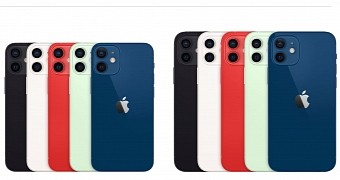Apple has officially launched the new iPhone 12 series, and needless to say, these devices come with important upgrades in several key areas.
But at the same time, worth reminding is that this year’s lineup comprises four different models, not three as it was the case in 2019. The addition of the iPhone 12 mini, which sports a 5.4-inch screen, is supposed to help expand the modern iPhone generation in more price ranges, while also providing existing Apple customers using older models with a new reason to upgrade to the latest hardware.
As it happens every year, the new iPhone 12 models that were announced this year come with multiple storage options, as it follows:
iPhone 12 mini and iPhone 12:
- 64GB
- 128GB
- 256GB
iPhone 12 Pro and iPhone 12 Pro Max:
- 128GB
- 256GB
- 512GB
In other words, while the most affordable iPhone 12 mini comes with 64GB of storage, the base iPhone 12 Pro and Pro Max is available with 128GB. As per Apple’s approach, there’s no microSD card support, so think twice before ordering your phone. If you run out of storage, there’s no way to expand it with a microSD card, so the cloud is the only way to go for you.
iPhones come with iCloud integration and 5GB available for free, but for anything beyond that, you need to pay extra.
At first glance, 64GB storage on the base iPhone 12 mini and iPhone 12 should be enough for the majority of users, especially if they don’t take a lot of photos. But on the other hand, worth knowing is that the amount of storage mentioned above isn’t actually how much is available on the device when you receive it.
The operating system and the pre-loaded apps both eat up a considerable amount of storage on the iPhone, so after setting up the device, you end up having a bit less space.
According to Apple itself, the operating system and the pre-installed apps can eat up between 11GB and 14GB of space, but this depends on how many apps you install and your own settings. The apps alone require 4GB, but the good news is that you can remove all of them to free up some space. So to be sure, you need to cut the aforementioned storage options by 14GB, which leads us to the following numbers:
iPhone 12 mini and iPhone 12:
- 50GB
- 114GB
- 242GB
iPhone 12 Pro and iPhone 12 Pro Max:
- 114GB
- 242GB
- 498GB
Is this enough? That's only up to you to decide, and it all depends on how you use your iPhone. But as a matter of fact, apps on iOS are getting bigger and bigger, and for example, Microsoft Outlook, one of the most popular email clients on iPhone, requires close to 300MB, all without any user settings.
“When you buy your iPhone, iPad, or iPod touch, it comes with a set storage capacity ranging from 16 to 512GB for iPhone, 16GB to 1TB for iPad, and 8 to 256GB for iPod touch. The music you buy, the apps you download, the photos you take, and all of the other content that you enjoy on your device uses its storage. And depending on your device capacity and how much content you have, your device can fill up and run out of storage,” Apple explains
“The operating system of your iPhone, iPad, iPod touch, and Mac reports storage capacity using the decimal system (base 10), which calculates 1GB as 1 billion bytes. This is the same measurement system used on the product packaging and specifications. iOS 10 and earlier, Mac OS X Leopard and earlier, Microsoft Windows, and watchOS use the binary system (base 2), which calculates 1GB as 1,073,741,824 bytes. This difference between the decimal and binary systems of measurement is why the reported storage capacity differs from the storage capacity on the product packaging or specifications.”
The iPhone 12 and iPhone 12 Pro is already available today, while the iPhone 12 mini and iPhone 12 Pro Max are projected to hit the shelves in November.

 14 DAY TRIAL //
14 DAY TRIAL //